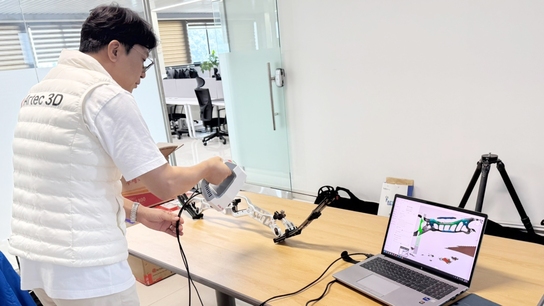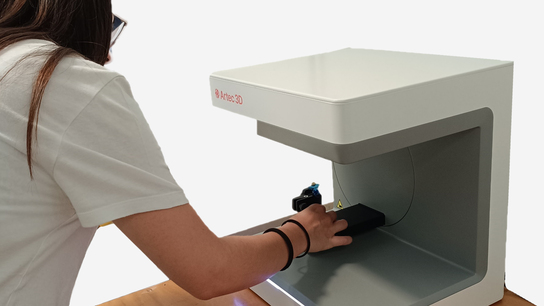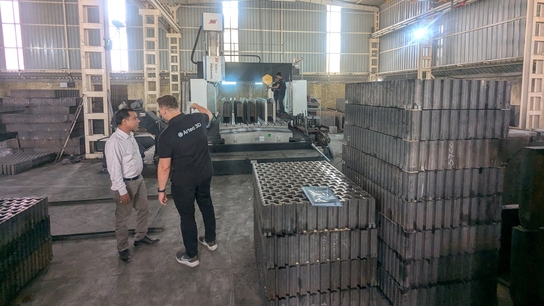Artec-Geomagic workflow allows for customization of chassis with bulletproof reliability
Challenge: A leading high-performance chassis design specialist searched for a way to dramatically speed up their day-to-day project workflow without compromising on accuracy or safety
Solution: Artec Eva, Artec Studio, Geomagic Design X
Results: Savings of hours to days of work by 3D scanning with Artec Eva for digitally capturing auto bodies, parts, and components and designing perfectly-fitting, custom-built chassis & FEA-enhanced auto parts for racing and special projects, including SEMA

Hosts of the Discovery Channel’s hit TV show Twin Turbos Doug & Brad DeBerti, with Jack Fisher scanning with Artec Eva
Jason Heard doesn’t lose a wink of sleep. Of the hundreds of high-performance chassis that he and his partner Jack Fisher have created over the years, not a single one has ever failed.
When it comes to what can go wrong on a car, especially as it’s racing across the landscape or around a track at breakneck speeds, aside from a major crash, most of what can happen isn’t life-threatening to the driver.
Whether a blown engine, an electrical system failure, or a transmission breakage, these events are rarely fatal. A chassis failure, on the other hand, is almost sure to be lethal.
That’s what makes modern high-performance chassis design such a demanding field. If the design is too lightweight, strength and safety are compromised. But if more material, or stronger ones, are used excessively, then performance is bound to suffer.
Achieving the ultimate strength-to-weight ratio in every project they bring to life is what Southern California chassis design specialists at Tekk Consulting Inc have been doing for years now.

Digital render of Artec Eva scans with custom Tekk Consulting chassis for Brad DeBerti’s “The Performance Truck”
Their pristine reputation in the industry as the guys who “just get it done” means booking clients months in advance and a steady flow of projects from private clients as well as the heavy-hitters in the industry, including several major OEMs, and others.
But it wasn’t always that way. Back in 2018, with more than a decade of chassis design under their belt, Tekk Consulting Inc had reached a point where even though the technical aspects of their work were unquestionably faultless, they were constantly in a race against the clock to complete their projects while maintaining the high standards they’re famous for.

Digital render of 1990 Ford Bronco parts scanned with Artec Eva
At the time, adding more clients wasn’t possible, and that meant not being able to take on the volume of projects necessary to push to the front of the pack in the insanely competitive industry of chassis design.
So Jason and Jack sat down and scrutinized their workflow from A to Z. They began looking for ways to make it tighter and faster, without sacrificing quality even in the least. One of the first things they focused on was how they were measuring auto bodies, parts, and components.
The traditional method of using calipers, tape measures, and rulers was how they guaranteed that the dimensions were accurate beyond a doubt. But it’s a painfully slow process, slapping on hours and even days to every project.
When they ventured online, they started reading about auto customizers and shops using 3D scanning to replace manual measurement methods. It was saving them hours on each project, they read. One search led to another, and they found their way onto the Artec 3D website.
There the Artec Eva caught their eye. A lightweight handheld 3D scanner, Eva captures millions of points every second, in minutes creating high-accuracy 3D models of auto parts and countless other kinds of objects. So, they picked up the phone and reached out to their local Artec dealer, Artec Ambassador Rapid Scan 3D, to arrange an onsite demo.
Rapid Scan 3D’s Chris Strong recalled the visit, saying, “During the demo, we scanned an off-road vehicle to capture data of the roll cages along with the suspension. These are some of the essential areas that need precise measurements for designing and fitting Tekk Consulting’s custom parts. Some of the challenges of their work include undercuts, suspension that’s in the way, and surfaces that can be difficult to reach or measure. But with Artec Eva, it was obvious right away that they can easily capture all the data they need, including those surfaces that would be tedious and time-consuming to acquire via manual measurement.”
As Heard put it, “That was it. In the first 15 minutes of the demo, we knew that we’d found our answer. So we bought it then and there. Didn’t need any training, it’s that easy to use. We didn’t even take a peek at the manual. We just bought it and then spent the rest of the afternoon scanning everything around the shop. By the end of the day, we had our workflow down pat.”

Jack Fisher scanning the rear of Brad DeBerti’s Ford F450 for Ford’s SEMA display in 2019 with Artec Eva
Since that moment, Tekk Consulting Inc has used their Artec Eva every day, on hundreds of projects including Brad Deberti’s @ThePerformanceTruck, work for the top 10 automakers, as well as all kinds of classics, muscle cars, multiple SEMA projects, and more.
Heard explained, “If you ask anybody who’s anybody in this business, they’ll tell you this: your reputation is your lifeblood. For whatever reason, if that goes out the door, you might as well hang up your hat and call it quits. That means no cutting corners, because safety is everything, and never ever bite off more than you can chew.”
He continued, “Our Artec Eva gives us the power to do more and do it better than we ever did before. With no sacrifices in accuracy or safety. In fact, now we can digitally capture whatever autobody structures or part geometries come our way, no matter how complex. Fast and precise.”

Jason Heard scanning the inside of a 2020 Toyota Tacoma cab with Artec Eva for the Deberti “The Performance Truck” project
Heard outlined his scanning workflow with Eva:
“For parts and components, I built a little lazy Susan (turntable) that I scan the parts on. If they’re shiny at all, I use a bit of baby powder or spray-on diffuser. That adds something like 1/5000th of an inch in surface coating, so it doesn’t affect the scan quality at all.”
He continued, “Then I just scan the part, two passes for one side, two passes for the other, just to make sure I’ve gotten everything. Then for the machine parts of the component, to get the exact spacing between bolt holes, and the holes themselves, for example, I just draw those in Geomagic Design X after measuring with a micrometer. It’s super easy and crazy fast this way.”
“When we’re scanning autobodies and cabs,” Heard said, “we typically scan in one major ‘geometry pass,’ which means grabbing the big structure. After that, we’ll come back and scan chunks here or there. Then we align these with the scan from the first pass. After this we process the scans in Artec Studio.”

Artec Studio screenshot during an Artec Eva scan of the DeBerti “The Performance Truck”
He explained his process in Artec Studio software: “I use the Eraser tool, which lets me easily swipe out anything I don’t want. The base of the lazy Susan, any props, etc. Depending on how much time I have, sometimes I do an auto-alignment, or do it manually, and then after everything’s aligned, I’ll do a Global Registration, etc.”
“But on big cabs and structures, I don’t do Global Registration, I just stick to Sharp Fusion, because that works perfect to keep everything together, looking as sharp as a tack.”
After that, they export the scans over to Design X/SOLIDWORKS 2020, where they start drawing the chassis.

3D Scan to CAD of a Ford 9” Third Member Assembly (for accurately designing fabricated rear end housing) from an Artec Eva scan
Eva made it possible for Tekk Consulting Inc to maximize the space within the truck (@ThePerformanceTruck), “where the chassis tubes are so perfectly laying against the skin of the truck,” and it also means having extra space within the cab, so your head is far enough away from the chassis itself. As a safety factor, in Heard’s words, “That’s huge.”
In the unfortunate event that the car or truck were to roll over, you always want to have enough distance between you and the chassis. With Eva, they have been able to maximize that to the fullest. “And that’s an epic plus for us. It’s a direct result of having a perfect scan of the body of the car or truck, which then lets us design a chassis that fits it like a glove.”

2-Seat Can Am X3 chassis, suspension, and components scanned with Artec Eva
Every auto customizer who’s ever needed CAD files from an OEM knows about the at-least-occasional frustration of waiting and waiting for them to arrive. To make it worse, when project deadlines are looming closer, and clients are calling you every day, that’s when patience wears thin.
As Heard put it, “If we had to wait around for CAD files before getting down to work, there’s no way we’d be able to achieve the tight deadlines we have, no way. So now we don’t have to wait. We just scan it ourselves, whether it’s a Porsche or a Toyota or a batch of parts, whatever.”

Quick Artec Eva scan of a GTR motor
He went on, “And when we compare our scans with Eva to the CAD files that eventually show up? Wow! You wouldn’t believe how closely they match up. Every time. At first we were surprised, but after hundreds of projects, we’ve gotten used to it. Now we don’t even wait for CAD files. We just scan and get down to work. That alone has saved us days of waiting.”

Artec Eva scan (blue) lined up with the OEM file from Toyota (Yellow) for the Brad DeBerti Toyota Tacoma “The Performance Truck”
As far as working with classic cars go, rarely if ever do such CAD files exist. That’s when 3D scanning can be a pivotal factor in moving forward on a project. Heard explained, “With Eva, I can scan parts or entire bodies of classics. Then that scan is mine. And it’s perfect to a T.”
He went on, speaking of the possibilities, “I can transform it however I want in Geomagic, 3D print or CNC mill it, or sell it online to one of thousands of shops around the world doing this kind of work. Shops with one, two, or three guys who are fabricators or builders that put out maybe 10 to 20 cars a year, that’s 90% of the industry right there.”
In regards to factory tolerances as part of the manufacturing process, these are also apparent when 3D scanning cabs and bodies straight from the assembly line. According to Heard, “It’s a known fact that CAD files from the OEM don’t take into account manufacturing tolerances. They just don’t.”
He elaborated, “If you’re working with an American car, you could have a 1/4” deviation, and that would be acceptable. On a really expensive foreign car, for example, it’ll be maybe 1/8”. Our scans with Eva are so much tighter than that. So when we see differences between the 3D scans and the CAD files, we take those tolerances into account.”
In terms of being able to scan more in one day than he could ever measure by hand, Heard weighed in, “To give you an example, just yesterday morning I scanned the front suspension for a brand-new Raptor, 360 degrees, everything. Then I scanned five different race seats, added in the mount geometry, and now the scans can be brought into any CAD file when we’re drawing a chassis, so these seats will be perfectly mounted.”

Can Am X3 chassis cutaway with Artec Eva scans of front control arms & components
Tekk Consulting Inc has embraced 3D scanning with Eva so fervently that they’ve begun selling their scans online via their digital marketplace at DIYoffroad.com. Over the years they’ve been contacted by hundreds of auto customizers and chassis designers in dozens of countries around the world. And the market is only growing bigger with time.
Heard has been recommending Artec Eva to everyone he can in the industry, without pause. In his words, “I’m totally fine with sharing what we do here. Including details about the amazing tech that we’ve been using. A huge thanks to our Eva, we are where we are today, with a backlog of work and the ability to pick and choose our projects.”
Jason Heard envisions a future where, “Every auto shop and designer is going to have their own 3D scanner and 3D printer. The market is already moving in this direction. That’ll mean specialists around the world creating digital assets, using them right there in their shops, or selling them online to other guys.”

Artec Eva scan of a ’33 Ford cab for one of Tekk Consulting’s SEMA projects
He explained further, “An example of what that can look like is this: some guy in Italy takes his Eva and scans a brand new Ferrari, or a classic one, along with whatever parts he wants, fenders, bumpers, etc., and then even hours later he bundles everything together into one package, or customizes it and turns it into a wide-body kit.”

Digital render of ’33 Ford, motor, and components scanned with Artec Eva
Another facet of the high-performance design work that Tekk Consulting Inc does is Finite Element Analysis (FEA) on scanned components, usually through the thin-shell approximation. This entails capturing the precise dimensions of parts and then analyzing their mechanical strength and stiffness, or how much they can bend and what that deflection looks like in CAD. This process allows them to redesign a component to address a failure point, while ensuring the component performs the same as, or better than, before.

Artec Eva scanned parts ready for FEA work in CAD
In the past that required hand measuring these components, which often took hours, including double-checking and re-measuring.
But now with their Eva in hand, they’re precisely capturing such parts in minutes. From control arms to swivel joints, roll bars to entire suspensions and more. No re-measuring or second-guessing needed.

Ready for FEA: Artec Eva scans of 2020 Ford Raptor suspension control arms
Heard explained why that’s so crucial, “It doesn’t matter how amazing your FEA is, if the data going in is flawed, even by just a fraction of an inch, that’s a recipe for disaster. There’s no way you’re going to accurately be able to mathematically bend and twist those components to prevent failure and increase performance. No way.”
He continued, “Our Eva has been such a game-changer for us in this. Now I’ll take a bunch of parts and scan them in before lunch. By the end of the day, we’ve done all our analysis and everything is smoothly on schedule to create the final design.”

A peek inside the DeBerti Toyota Tacoma “The Performance Truck,” with Tekk Consulting custom chassis firmly in place
To summarize the impact that Eva has had on their work, Heard added, “When you’re trying to build a race car and you have a phase that used to take you 14 to 16 hours in the past, and now it takes you just 2 to 3 hours, that makes a massive difference to us, and that’s not even touching on the accuracy and safety angles of what 3D scanning with Artec Eva has given us.”
Scanners behind the story
Try out the world's leading handheld 3D scanners.





